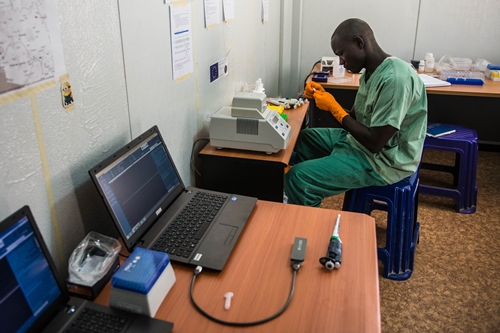3 February 2016. An international team of scientists and engineers designed a mobile system using a hand-held genome sequencing device that provided real-time monitoring of the Ebola outbreak in West Africa in 2015. Researchers led by microbiologists Nicholas Loman and Joshua Quick at University of Birmingham in the U.K. published their findings in today’s (3 February) issue of the journal Nature.
The researchers from Loman’s group at Birmingham and elsewhere in Europe, Africa, Canada, and the U.S. were responding to the long delay in conclusively identifying Ebola viruses in patients during the height of the outbreak in West Africa in the spring of 2015. Sequencing viruses’ genomes can provide vital data to guide control efforts by health authorities, but sequencing required sending samples to remote labs, in some cases outside of Africa. The results of remote sequencing, which provide target signatures for therapies and identify mutations in the virus, were sometimes obsolete by the time they were reported to clinicians and health authorities.
To conduct the sequencing, researchers used the MinIon, made by Oxford Nanopore Technologies. MinIon is a disease surveillance system that analyzes DNA from blood samples, and operates as a plug-in peripheral on a laptop computer. Because MinIon is powered by the host laptop computer, it does not need an additional power source, unlike high-powered conventional DNA sequencing systems.
The MinIon technology is based on straining and isolating individual DNA strands through nanoscale pores in a membrane that allows for electronic sequencing processes to identify the base components of DNA passing through the pore. As reported in Science & Enterprise, astronauts aboard the International Space Station are testing the feasibility of portable DNA sequencing in space using the MinIon.
Loman, Quick, and colleagues built a mobile system built around the MinIon that could be transported easily and deployed in field sites. The entire system, including the laptop computer hosting the MinIon fits into an ordinary suitcase and weighs less than 50 kilograms (110 pounds), the weight limit for airline luggage.
The Birmingham team worked with European Mobile Laboratory Project and World Health Organization to test the system on the ground in Guinea from March to October 2015. During that time, researchers sequenced 142 samples from patients, with the sequencing itself taking no more than 60 minutes, and providing analytical results in less than 24 hours.
“Having a portable DNA sequencing system opens up the possibility to do outbreak genome sequencing in real-time,” says Loman in a university statement, “which can directly impact on the response on the ground, as well as providing a wealth of information about pathogen evolution. Crucially we shared our data as it was generated, increasing its use immensely.”
While WHO declared the outbreak officially over in January 2016, isolated cases of Ebola continue to be reported. The research team left the sequencing system in Guinea for health authorities to continue their surveillance of the disease.
Read more:
- Regeneron to Develop Antibody Therapy for Ebola
- Point-of-Care Ebola Test Found Accurate in Field Test
- Intermediate Trial Shows Ebola Vaccines Safe
- Paper Strip Test Developed for Ebola, Other Diseases
- Biotech Licenses Cell Research for Ebola Treatments
* * *


 RSS - Posts
RSS - Posts
[…] Ebola Monitoring System Devised with Genome Sequencing […]